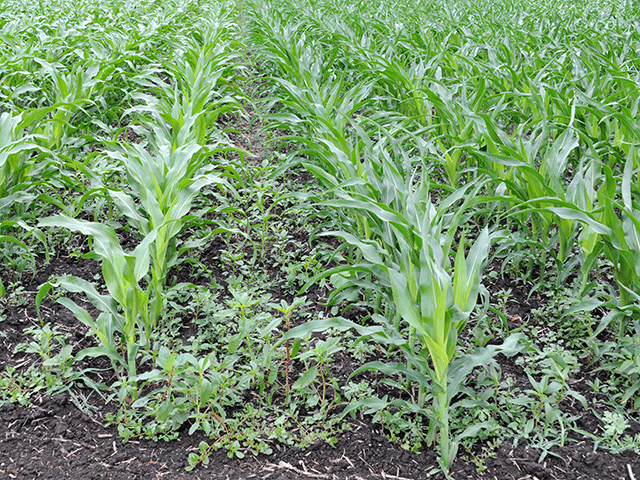The High Cost of Weeds
Why Cutting Early Season Weed Control Doesn't Pay Off
ROCKVILLE, Md. (DTN) -- By the time your sprayer rolls into a 12-inch corn field and zaps a row full of 4-inch waterhemp, you've already lost yield to those baby weeds.
That's a hard thought to stomach, but there is growing research to back it up. That science was on display during a Commodity Classic session on the effect of crop pests on productivity on Wednesday.
The problem is that weeds start stealing water, nutrients and sunlight from your crops from germination onward, explained Mark Kitt, a technical product lead for herbicides with Syngenta.
From 2006 to 2008, Syngenta researchers took scissors to 20 different field sites. When they found weeds from 2 to 4 inches tall, they snipped them off at the ground level and shipped them off for lab testing to see how many nutrients they had accumulated. They found that even at that early stage, the weeds had removed almost $8 per acre worth of nitrogen, phosphorus and potash from the soil, making it unavailable for the growing crops around them.
As for water, the Syngenta scientist highlighted the 3:3:1 rule, which states that in three days, 3-inch weeds can remove 1 inch of water from the soil.
Kitt also spotlighted past research from the University of Guelph, which shows that in the presence of weeds within a row, corn plants orient their leaves away from weeds instead of spreading out over the canopy and collecting as much sunshine as possible. That limits how much light they can intercept and the result is permanently smaller root masses, even if the weeds are later controlled.
P[L1] D[0x0] M[300x250] OOP[F] ADUNIT[] T[]
"Plants determine stress very early on from weed competition and once this happens, they start to compete with the weeds, they fix their growth pattern, and there's no going back," Kitt said.
So what does this mean for farmers? Spray early and spray well, said Bill Johnson, a Purdue Extension weed scientist.
He's noticed a trend among corn growers in particular to move away from adding full rates of residuals in their pre-emergence applications, in favor of focusing on post-emergence applications to clean up weeds later into the season, in part to cut down on input costs.
That strategy doesn't pay off, he stressed.
"We like to see folks utilize full rates of residual herbicides, combined with timely postemergence application to create an environment in corn where you have almost no weed competition at all," he urged. "Year in and year out for the past 25 years, that is the highest-yielding treatment in our research program."
It can seem counter-intuitive -- a robust preemergence application with multiple active ingredients including full rates of residual herbicides can be a significant added cost. But Johnson's field trials showed that the highest economic net return, based on $4 corn prices, came from plots that got that treatment, combined with a timely post-emergence application of two active ingredients.
The weaker the residual in the pre-emergence package, and the later the post-emergence application slipped beyond V4 corn growth stages, the lower the net returns.
It can be hard to spend money on aggressive early season weed control when commodity prices are low, conceded Allan Gray, an ag economist and director of the Center for Food and Agricultural Business at Purdue University. He recommends that growers try to think of their costs in per bushel terms, rather than per acre. "We don't produce and sell acres," he said. "We sell bushels. Spending additional money will always look like it raises costs when you measure it on a per acre basis, but that ignores increased yield outputs."
It's true that if you spend more on weed control, for example, your chemical costs and fuel costs might rise per bushel, but your fixed overhead costs -- labor, land, machinery -- will shrink per bushel as your expected yield grows, he said.
"Thinking about the productivity -- i.e. yield -- impacts of input decisions is critical," he concluded. "When you consider input cost reductions, you need to factor in yield losses; when you consider cost increases, you need to factor in yield gains."
And since weeds are one of the most dependable yield robbers, weed control is one of the most consistent and valuable yield protectors, Johnson stressed.
"You're never going to gain or regain 100% of your yield potential when you allow weed competition to occur at multiple times in a growing season," he said.
Emily Unglesbee can be reached at Emily.unglesbee@dtn.com
Follow her on Twitter @Emily_Unglesbee
(c) Copyright 2021 DTN, LLC. All rights reserved.






